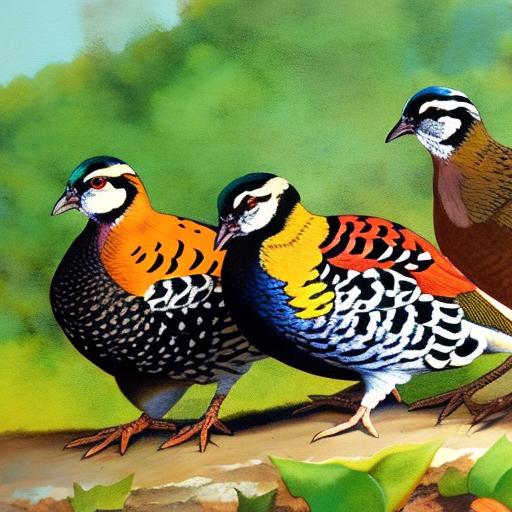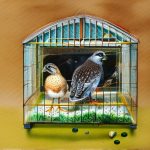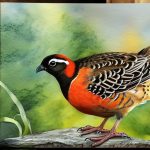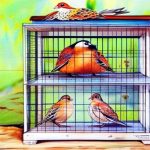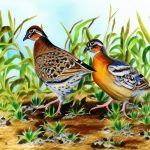Harlequin quails, also known as Chinese painted quails, are small, colorful birds that are popular among aviculturists for their charming appearance and easy breeding habits. Breeding these quails can be a rewarding and enjoyable experience for bird enthusiasts, as they are relatively easy to care for and breed in captivity. Harlequin quails are known for their vibrant plumage, with males displaying striking black and white markings, while females have more subdued brown and white feathers. These quails are also known for their distinctive call, which adds to their appeal as pets or breeding birds.
Breeding harlequin quails can be a fascinating hobby or a profitable venture for those interested in aviculture. With the right knowledge and preparation, breeding these birds can be a relatively straightforward process. In this comprehensive guide, we will explore the various aspects of harlequin quail breeding, from selecting the right breeding stock to managing the hatching and rearing of chicks. Whether you are a beginner or an experienced breeder, this guide will provide you with valuable insights and practical tips for successfully breeding harlequin quails.
Key Takeaways
- Harlequin quail breeding can be a rewarding and enjoyable experience for enthusiasts.
- Selecting the right breeding stock is crucial for producing healthy and high-quality quail offspring.
- Creating the ideal breeding environment involves providing proper housing, nutrition, and space for the quails.
- Understanding the breeding process, including mating behavior and egg laying, is essential for successful breeding.
- Caring for quails during breeding involves monitoring their health, providing proper nutrition, and ensuring a stress-free environment.
Selecting the Right Breeding Stock
Selecting the right breeding stock is crucial for successful harlequin quail breeding. When choosing breeding birds, it is important to select healthy, disease-free individuals with desirable traits such as vibrant plumage and good temperament. Look for birds that are active, alert, and free from any signs of illness or deformities. It is also important to consider the genetic diversity of the breeding stock to avoid inbreeding and maintain the overall health and vigor of the offspring.
When selecting breeding stock, it is advisable to start with a small group of quails, ideally one male and two to three females. This will help to ensure a balanced breeding ratio and reduce the likelihood of aggression or competition among the birds. Additionally, it is important to consider the age of the breeding stock, as older birds may have reduced fertility and reproductive success. By carefully selecting the right breeding stock, you can lay a solid foundation for a successful and sustainable breeding program.
Creating the Ideal Breeding Environment
Creating the ideal breeding environment is essential for promoting successful breeding and reproduction in harlequin quails. The breeding environment should mimic the natural habitat of these birds, providing them with the necessary space, shelter, and resources for courtship, mating, and nesting. A spacious aviary or breeding enclosure with plenty of hiding spots, nesting boxes, and soft bedding material will help to create a comfortable and secure environment for the breeding birds.
It is important to provide a balanced diet rich in protein, vitamins, and minerals to support the health and reproductive performance of the breeding quails. Fresh water should be readily available at all times, and it is advisable to supplement their diet with calcium to support egg production and shell quality. Maintaining optimal environmental conditions, such as temperature and humidity, is also crucial for promoting successful breeding. By creating a suitable breeding environment, you can help to minimize stress and maximize the breeding potential of your harlequin quails.
Understanding the Breeding Process
Understanding the breeding process is essential for effectively managing and supporting the reproductive behavior of harlequin quails. Breeding typically occurs in response to environmental cues such as changes in daylight length, temperature, and food availability. During the breeding season, male quails will display courtship behavior such as strutting, calling, and offering food to females to attract their attention and establish pair bonds.
Once pair bonds are formed, mating will occur, with males mounting females to copulate. Female quails will then begin laying eggs in the nesting boxes provided, typically laying one egg per day until a clutch of eggs is complete. It is important to monitor the breeding behavior of the quails closely to ensure that mating and egg-laying are occurring regularly. By understanding the natural breeding process of harlequin quails, breeders can anticipate and support their reproductive needs more effectively.
Caring for Quails During Breeding
Caring for quails during the breeding process involves providing them with proper nutrition, monitoring their health and behavior, and ensuring that they have a safe and comfortable environment for nesting and rearing their chicks. It is important to provide a well-balanced diet that meets the nutritional needs of breeding quails, including high-quality protein sources such as mealworms, crickets, and commercial game bird feed. Additionally, providing access to calcium supplements will support egg production and prevent calcium deficiencies in laying females.
Regular health checks should be conducted to monitor the condition of the breeding birds and identify any signs of illness or reproductive problems. It is important to observe their behavior closely, paying attention to signs of aggression, stress, or nesting behavior. Providing nesting boxes filled with soft bedding material will give female quails a suitable place to lay their eggs and incubate them until they hatch. By caring for quails during the breeding process with diligence and attention to their specific needs, breeders can support their reproductive success and overall well-being.
Managing the Hatching and Rearing of Chicks

Managing the hatching and rearing of chicks is an exciting but critical phase in harlequin quail breeding. Once eggs are laid, they should be collected daily to prevent them from being damaged or eaten by other birds. The collected eggs can be placed in an incubator set at the appropriate temperature and humidity levels for hatching. It is important to monitor the development of the embryos closely and intervene if any issues arise during incubation.
After hatching, the chicks should be transferred to a brooder with a heat source to maintain their body temperature until they are fully feathered. Providing them with a balanced diet rich in protein will support their growth and development during the rearing phase. It is important to monitor their health and behavior closely, addressing any issues such as deformities or illness promptly. By managing the hatching and rearing of chicks with care and attention to their specific needs, breeders can ensure the successful growth and development of the next generation of harlequin quails.
Troubleshooting Common Breeding Issues
Despite careful planning and management, breeders may encounter common issues during the harlequin quail breeding process. These issues may include low fertility rates, egg infertility or deformities, poor hatchability, or chick mortality. To troubleshoot these issues effectively, it is important to identify potential causes such as nutritional deficiencies, environmental stressors, or genetic factors that may be impacting reproductive performance.
Addressing these issues may involve adjusting the diet of breeding birds to ensure they receive adequate nutrition for reproduction, optimizing environmental conditions such as temperature and humidity in the breeding enclosure, or seeking veterinary assistance to address any health concerns that may be affecting reproductive success. By troubleshooting common breeding issues systematically and addressing them proactively, breeders can improve their breeding outcomes and maintain healthy and productive harlequin quail populations.
In conclusion, harlequin quail breeding can be a rewarding and enjoyable endeavor for bird enthusiasts who are passionate about aviculture. By selecting the right breeding stock, creating an ideal breeding environment, understanding the breeding process, caring for quails during breeding, managing the hatching and rearing of chicks, and troubleshooting common breeding issues effectively, breeders can promote successful reproduction and maintain healthy populations of these charming birds. With dedication, knowledge, and careful management, breeders can experience the joy of witnessing new generations of harlequin quails thrive under their care.
If you’re interested in harlequin quail breeding, you may also want to explore the topic of poultry nutrition. Understanding what to feed ducks and chickens is essential for their health and productivity. Poultry Wizard offers a helpful article on what to feed ducks, which can provide valuable insights into the dietary needs of various poultry species. Proper nutrition is crucial for successful breeding and raising of quails, so learning about feeding practices for other poultry can be beneficial.
FAQs
What is harlequin quail breeding?
Harlequin quail breeding refers to the process of breeding and raising harlequin quail, a small species of bird known for its colorful plumage and distinctive markings.
What do harlequin quails eat?
Harlequin quails are omnivorous and their diet typically consists of a combination of seeds, insects, and small plants. In captivity, they can be fed a commercial game bird feed supplemented with fresh greens and insects.
How long does it take for harlequin quails to reach breeding age?
Harlequin quails typically reach breeding age at around 8-10 weeks old.
How do you set up a breeding environment for harlequin quails?
A breeding environment for harlequin quails should include a spacious cage or aviary with nesting boxes, a substrate for nesting, and a balanced diet to support breeding activity.
What is the breeding season for harlequin quails?
Harlequin quails are known to breed throughout the year, but they may exhibit increased breeding activity during the spring and summer months.
How many eggs do harlequin quails lay?
Harlequin quails typically lay between 6-12 eggs in a clutch, with the female being the primary caretaker of the eggs and chicks.
How long does it take for harlequin quail eggs to hatch?
Harlequin quail eggs typically take around 16-18 days to hatch after being laid.
What are some common challenges in harlequin quail breeding?
Common challenges in harlequin quail breeding include ensuring proper nutrition, providing a suitable breeding environment, and managing potential health issues such as parasites or diseases.
Meet Walter, the feathered-friend fanatic of Florida! Nestled in the sunshine state, Walter struts through life with his feathered companions, clucking his way to happiness. With a coop that’s fancier than a five-star hotel, he’s the Don Juan of the chicken world. When he’s not teaching his hens to do the cha-cha, you’ll find him in a heated debate with his prized rooster, Sir Clucks-a-Lot. Walter’s poultry passion is no yolk; he’s the sunny-side-up guy you never knew you needed in your flock of friends!

